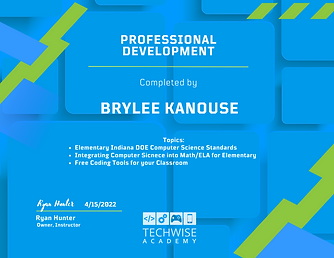
Welcome to Miss
Brylee's Efolio
Elementary Education Major
Rationale/Reflection
Standard #9 Professional Learning and Ethical Practice:
The teacher engages in ongoing professional learning and uses evidence to continually evaluate his/her practice, particularly the effects of his/her choices and actions on others (learners, families, other professionals, and the community), and adapts practice to meet the needs of each learner (InTASC,2013).
Brief Description of Evidence:
In the spring semester of 2022, in my EDUC 250 Educational Psychology class, I was given opportunities to engage myself in ongoing professional learning such as Techwise Training and Suicide Prevention Training, along with this I have been using a website called TeachThough.com to help grow my knowledge in education. As a group, we participated in a professional development opportunity called Techwise Academy. The purpose of participating in this event was to expand my knowledge and understanding of technology and engineering inside the classroom. I was able to manipulate online websites by playing games and getting to build and code my own robot with a partner. This training gave me the hands-on experience to understand how it is beneficial to students and what free resources are available to me. I was able to continue my professional learning and ethical practices by going to a suicide prevention training which taught me that social media and technology impact the lives of everyone. During the training, I was able to listen to thoughtful questions to ask those who look like they need help. One question is “Are you thinking about suicide?” Or "what do you mean by that," in response to vague terms such as the word “good.” I also got to interact in a real scenario as to how I would respond to a student in my class.
Analysis of What I Learned:
In the Techwise training, I was able to engage in the learning process from the student and teacher’s point of view through an online website called code.org. I saw what the students would do and how they would solve the problem, but I was also able to see how a teacher could assign tasks to their students and what it looks like on their side of the screen. This training taught me how different forms of technology can enhance learning in the classroom by really being able to use all different types of learning styles. The instructor advised us on how we can adapt each challenge to meet all individual learners' needs by selecting specific themed games that have different levels of difficulty. It really helped me understand how much STEM grows the mindset in a positive manner by getting to think about the reasons behind why something works a specific way. In the suicide training, I was able to see that the vague response of someone can really be a cry for help and if I do not act upon that issue they may not feel seen and end up taking their own life. In the suicide prevention, I was able to learn how to truly get someone to deescalate in mental breakdown scenarios. I have experienced friends who have attempted taking their own life, and a fear of mine is seeing that same fear in another's eyes, one being my future students. I now know that finding the root of the issue really brings light to the scary situations for individuals and using the word “suicide” is completely okay.
How This Artifact Demonstrates my Competence on the InTASC Standard:
This artifact demonstrates my competency by engaging in ongoing professional learning by completing a Techwise training, suicide prevention training, and completing research on an online website called TeachThought.com which gives online professional development resources. At the end of each training, I used a guided questionnaire to evaluate my evidence and understanding of what I learned within the time of my training. The questions allowed me time to reflect on my own learning. By completing the Techwise training I was able to see the effects choices and actions about technology can have on my students. It really helped me understand how much STEM grows the mindset in a positive manner by getting to think about the reasons behind why something works a specific way. In the suicide training, I was able to see that the vague response of someone can really be a cry for help and if I do not act upon that issue they may not feel seen and end up taking their own life. I am able to meet the needs of all my learners by making sure I am incorporating new ways of thinking within my classroom by implementing code.org and allowing them to use downtime in the classroom to really grow their minds while having fun. I am also going to incorporate daily check-ins in my classroom as students are doing morning work, walking around, and talking to every individual child so they all feel heard. After completing the suicide prevention training, I was really able to see individuals just need a safe person to show they care. My artifacts and standards really connect with Carol Dweck and her growth mindset theory (Mindset, 2017). Her theory says if everyone thinks there is a way for them to get smarter they will achieve a higher accomplishment. I am constantly looking for ways to grow as a person and most of all as an educator to reach my highest potential of achievement for my students. If I am more knowledgeable my classroom is more likely to succeed.
Citations:
Council of Chief State School Officers. (2013, April). Interstate Teacher Assessment and Support Consortium InTASC Model Core Teaching Standards and Learning Progressions for Teachers 1.0: A Resource for Ongoing Teacher Development. Washington, DC: Author.
The Growth Mindset - What is Growth Mindset - Mindset Works. (2017). Mindsetworks. https://www.mindsetworks.com/science/#:%7E:text=Dweck%20coined%20the%20terms%20fixed,that%20leads%20to%20higher%20achievement.


.png)